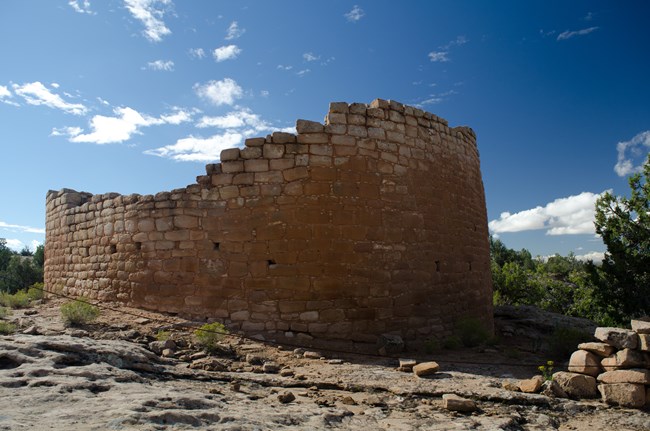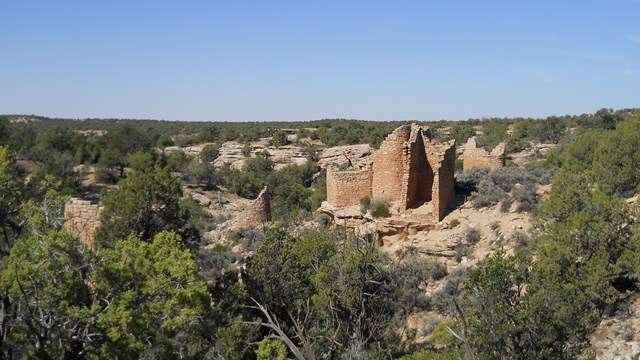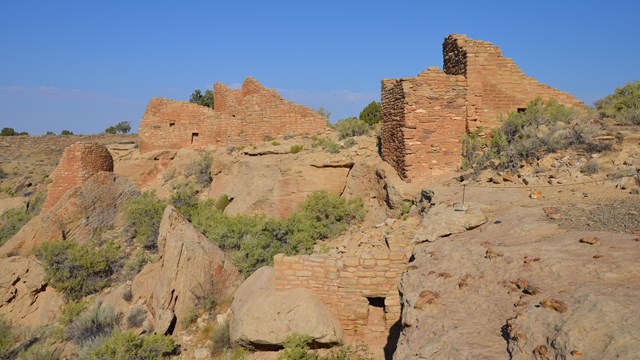
NPS photo Horseshoe and Hackberry are two separate Hovenweep units located within the same NPS boundary. Both units sit around a canyon head – the main drainage and west fork of Hackberry Canyon. Horseshoe is known for its impressive views of surrounding canyon country. Hackberry is now mostly rubble, but was the largest community in the park. A primitive trail leads along the canyon rim to both units. Visiting Horseshoe & HackberryGetting ThereStop at the visitor center for updated road conditions, directions, and a map. Horseshoe & Hackberry units are located down an unimproved BLM road off of County Rd 10, 4 miles north of Hovenweep’s visitor center and campground. High clearance vehicles are strongly recommended. Hiking is required to see Horseshoe and Hackberry. The trail to Horseshoe is 0.64 mile (1 km) roundtrip. Hiking the entire trail to Hackberry and back is 1.44 miles (2.32 km) and should take 30 minutes to an hour. Available ServicesThere is no rest room, campground, visitor center, trash receptacle, or water available at the Horseshoe/Hackberry site, so come prepared. All of these services are available at the visitor center. 
NPS photo What’s in a NameHorseshoe was named for the distinctive horseshoe-shaped structure situated on the rim of Hackberry Canyon. Hackberry, also situated along a part of Hackberry Canyon, was named for the profusion of Hackberry trees growing in the canyon in the vicinity of the village. Features & ArcheologyHorseshoe/Hackberry is located within a 137-acre unit in the juniper-sage vegetation zone on Cajon Mesa. Each pueblo had a reliable source of water in the springs at the head of their drainages, as evidenced by the trees and other vegetation growing in the drainages. These sites were occupied from Basketmaker III through Pueblo III, approximately A.D. 450 to 1300. HorseshoeHorseshoe is dominated by Horseshoe House and Horseshoe Tower. Horseshoe House is a two-story, D-shaped and double-walled building oriented so that its straight wall runs along the rim of the canyon head. The interior of Horseshoe House is divided into four room around a circular, kiva-like room. Still visible are the remnants of a wall extending from the building out along the edge of the canyon and a two-story round, kiva like building under the canyon edge overhang below Horseshoe house.Horseshoe Tower is located approximately ½ mile south of Horseshoe House at the end of the point where the two forks of Hackberry Canyon meet. The tower site includes a walled-off tower and a room block on the mesa beyond the wall. 
NPS photo HackberryAlthough Hackberry has fewer standing buildings than the other Hovenweep units, it has the distinction of being the largest prehistoric Puebloan village in the monument. What remains of structures such as towers, mesa-top room blocks and other types of habitation buildings, walls, storage shelters, rock wall garden terracing along the slopes of the canyon, and water control structures such as check dams are all in evidence. Life at Horseshoe & HackberryThe ancestral Puebloans living at Horseshoe/Hackberry supplemented the food they collected from hunting and gathering by farming. They grew corn, squash and beans in terraced plots down the slope of the drainage and in plots of land on the mesa top by utilizing dry-land farming techniques. There also is evidence at the Horseshoe/Hackberry sites that that the Puebloans used water control devices such as arroyo check dams in the canyon bottom to support the cultivation of their crops. Besides farming, the Horseshoe/Hackberry residents would have been involved with making pottery, clothing, and stone tools to use for hunting, building and food preparation. In addition, a significant amount of time would have been spent constructing their buildings. Part of the ParkHorseshoe and Hackberry were included in the 1923 Presidential proclamation that designated Hovenweep as a national monument. Other Places to GoHovenweep's Home BaseSquare Tower Group
Cutthroat Castle
Hovenweep's northernmost and hardest to reach unit. 
Holly
Holly is Hovenweep's most visited outlying unit. 
Cajon
Cajon is Hovenweep's southernmost and least visited outlying unit. |
Last updated: April 18, 2025
